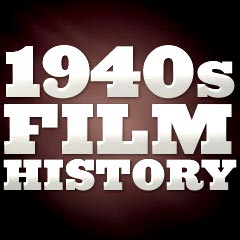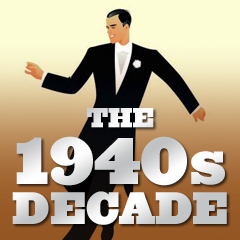 |
Part 5 Film History of the 1940s Part 1, Part 2, Part 3, Part 4, Part 5, Part 6 Film History by Decade Index | Pre-1920s | 1920s | 1930s | 1940s | 1950s | 1960s 1970s | 1980s | 1990s | 2000s | 2010s |

|
|
40s Musicals:
Hollywood enjoyed its greatest financial year in history in 1946. An all-time peak in annual box-office receipts, at $4.5 billion, was achieved. The best of Broadway revues was remembered in Ziegfeld Follies (1946), with William Powell reprising his role as the great Broadway impresario. Cameos and appearances by many stars, such as Judy Garland, Fred Astaire, Red Skelton and Lucille Ball, populated the film. Arthur Freed was the driving force behind MGM studios and the growth of the musical genre in the 40s and 50s. Gene Kelly made his official screen debut as a song-and-dance man in director Busby Berkeley's (and producer Freed's) hit musical For Me and My Gal (1942), opposite Judy Garland (her first film with her name billed alone above the title in the credits).
Entertainer Al Jolson and bandleader Paul Whitehead starred as themselves in Rhapsody in Blue (1945), the life story of American composer George Gershwin (played by Robert Alda - Alan Alda's father), noted for writing An American in Paris. The musical biography Night and Day (1946) was the life account of songwriter Cole Porter (Cary Grant), and featured Mary Martin singing "My Heart Belongs to Daddy." Cornel Wilde starred as the Polish composer Frederick Chopin in Columbia Pictures' hit musical biopic A Song to Remember (1945), with Merle Oberon as George Sand and Stephen Bekass as Franz Liszt. The hugely-successful The Jolson Story (1946) was an energetic film biography of one of America's most popular vaudeville entertainers of the 1920s, known for singing: "Mammy!", "California, Here I Come," and "Swanee". The film was followed by a sequel: Jolson Sings Again (1949) with Larry Parks again in the lead role.
The hit Broadway comedy The Man Who Came to Dinner (1942) was adapted for the screen and directed by William Keighley for Warners - it starred Bette Davis, Ann Sheridan, and Monty Woolley (as the unwelcome title character Sheridan Whiteside). Claude Rains starred in Universal's Technicolor musical remake of the original horror film The Phantom of the Opera (1943) as the title character violinist Enrique Claudin, forced to wear a mask to cover his disfigurement, and madly in love with opera singer Christine (Susanna Foster). Betty Grable's legs were prominently displayed in the musical Mother Wore Tights (1947), a turn-of-the-century story about a vaudeville family, starring Dan Dailey. A non-musical version of the future The King and I (1956), the romantic drama Anna and the King of Siam (1946), starred Irene Dunne as Western teacher Miss Owens and Rex Harrison (in his screen debut) as the Thai monarch. [This film was remade with Jodie Foster as Anna and the King of Siam (1999).] The biggest hit film of 1944 was the heart-warming, Oscar-winning musical comedy Going My Way (1944), starring Bing Crosby and Barry Fitzgerald as conflicting members of the Roman Catholic clergy. [The film was first screened on 65 different military bases on April 27, 1944, as a way to support the war effort.] Its equally-popular sequel released the following year, The Bells of St. Mary's (1945), starred Bing Crosby and Ingrid Bergman. Life With Father (1947) was a screen version of the hit Broadway play of a turn-of-the-century New York family. Danny Kaye starred as the title character - a hapless daydreamer who imagines himself in heroic adventures, in the fantasy musical comedy The Secret Life of Walter Mitty (1947) - known for the sound of his imaginary life-saving machine ("ta-pocketa, pocketa"). Judy Garland was at the height of her talents in MGM's In the Good Old Summertime (1949), a musical remake of The Shop Around the Corner (1940), about two anonymous pen pals. "Soundies": From 1940-1946, soundies (short black and white musical films) were produced. They were pre-cursors to present-day music videos, and were designed to be played on coin-operated, 16 mm rear-projection machines like jukeboxes, called Panorams, that were located in nightclubs, diners, roadhouses, bars, restaurants and other public places. Besides musical numbers representing many different musical styles (swing, big band, jazz, blues, country and western, hillbilly, Gospel, Latin American, Hawaiian, dance, musical comedy, and more), soundies would often include cheesecake sequences of women in bathing suits, vaudeville acts, or strip-tease/burlesque routines. Because they were produced during the war years, they also featured war bonds appeals and other patriotic jargons. Films of Social Concern and Realism: "Liberal" Hollywood crusaded against injustices and inequities in moving films of social concern:
There were four gripping Hollywood dramas in particular that dealt seriously with the subject of contemporary race relations, that were released in 1949:
Hitchcock and Other British/Foreign Influences: After many great British films in the 1930s (The
Thirty-Nine Steps (1935) and The Lady Vanishes (1938),
for example),
Hitchcock also made some superb psychological thrillers: the favorite of all of his films was Shadow of a Doubt (1943) about a psychopathic 'Merry Widow' killer named Charlie (Joseph Cotten) in a small California town. Hitchcock's psychoanalytic, post-war mystery Spellbound (1945) (produced by David O. Selznick) contained Dali's surrealistic dream sequence and featured psychiatrist Gregory Peck suffering from amnesia. The spy thriller Notorious (1946) was a dark foreboding story of an espionage scheme to trap a Nazi agent. These films reflected post-war acceptance of a darker style of film-making. It wasn't until Rope (1948) that Hitchcock switched to color, in an experimentally-ambitious film seamlessly put together with ten-minute extended takes.
Lean's melodramatic tear-jerker Brief Encounter (1946), heightened by Rachmaninoff's piano concerto, told a story of unfulfilled romance between a married middle-class woman (Celia Johnson) and a doctor (Trevor Howard) - at a railway station tearoom.
French director Jean Cocteau directed the classic live-action, love drama La Belle et La Bete (Beauty and the Beast) (1946) - a remarkable, visually surrealistic, and unique re-telling of the fairy tale. And Marcel Carne's post-war romantic drama masterpiece Les Enfants Du Paradis (1945), a bittersweet tale set in 19th century Parisian theatre and secretly filmed during the Nazi occupation, was acclaimed for its lyrical beauty and doomed passion. British Comedy Stars and Ealing Studios: The most popular British film star comic of the late 1930s and early 1940s (of the pre-TV era from the mid-30s to the mid-40s) was George Formby, noted for playing a ukulele, morale-boosting during the war years, singing songs with double-entendres, and repeating the catchphrase: "Turned out nice again." His notable films included Keep Your Seats Please (1936), Keep Fit (1937), and It's In the Air (1938). Another of the most favorite British comedians was Will Hay. In films from Ealing Studios, his most famous character was an incompetent school master with a pince-nez, often playing opposite toothless Moore Marriott and fat Graham Moffatt. The last film Will Hay co-directed was My Learned Friend (1943) before his death at the end of the decade. British film comedy reached its creative zenith in the 40s with productions made by the short-lived Ealing Studios. One of Ealing's most whimsical political satires in the late 1940s was Passport to Pimlico (1949), starring Margaret Rutherford and Stanley Holloway in a tale about a district in South London that was determined to belong to Burgundy, France. Another British black comedy from Britain's Ealing Studios, Kind Hearts and Coronets (1949) featured Alec Guinness in eight roles in the film, and was considered the best comedy of its year. Director Alexander Mackendrick's Ealing release of Whiskey Galore! (1949) (aka Tight Little Island) was also well-revered. The independent studio would become well-known for its late 40s and early 50s comedies, such as The Lavender Hill Mob (1951), The Man in the White Suit (1951), and The Ladykillers (1955). Laurence Olivier and Other Prominent British Stars:
British actress Deborah Kerr's first Hollywood success was in her debut US film The Hucksters (1947). Powell and Pressburger:
Later, their psycho-voyeuristic horror-thriller film Peeping Tom (1960) was controversial for its twisted view of a homicidal, psychopathic photographer. Italian Neo-Realism:
Other representative Neo-realism examples included: Rossellini's Paisan (1946), De Sica's Shoeshine (1946), Rossellini's Germany, Year Zero (1947), Visconti's La Terra Trema (1948), Rossellini's Stromboli (1949), and De Sica's Umberto D (1952). Italian Neo-Realism, portrayed by film-makers Rossellini, Luchino Visconti and Vittorio De Sica, lasted until 1952.
Part 1, Part 2, Part 3, Part 4, Part 5, Part 6 |